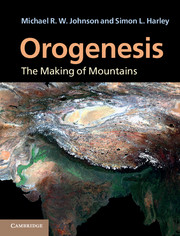Book contents
- Frontmatter
- Contents
- Preface
- Acknowledgments
- Geological timescale
- 1 Major features of the Earth and plate tectonics
- 2 Driving mechanisms for plates, slab retreat and advance, and a cause of orogenesis
- 3 Physical and chemical principles: rock deformation, isostasy, geochronology and heat production in the lithosphere
- 4 Large-scale features of orogens: thrusts and folds
- 5 Evolution of orogens
- 6 Lateral spreading of orogens: foreland propagation, channel flow and weak zones in the crust
- 7 Metamorphism in orogeny
- 8 The erosion and exhumation of mountains
- 9 Sedimentary history of the foredeep basins
- 10 Deep structure, mountain support and phase changes
- 11 Mountains and climate
- 12 Secular change in orogeny
- References
- Index
- Plate section
- References
6 - Lateral spreading of orogens: foreland propagation, channel flow and weak zones in the crust
Published online by Cambridge University Press: 05 June 2012
- Frontmatter
- Contents
- Preface
- Acknowledgments
- Geological timescale
- 1 Major features of the Earth and plate tectonics
- 2 Driving mechanisms for plates, slab retreat and advance, and a cause of orogenesis
- 3 Physical and chemical principles: rock deformation, isostasy, geochronology and heat production in the lithosphere
- 4 Large-scale features of orogens: thrusts and folds
- 5 Evolution of orogens
- 6 Lateral spreading of orogens: foreland propagation, channel flow and weak zones in the crust
- 7 Metamorphism in orogeny
- 8 The erosion and exhumation of mountains
- 9 Sedimentary history of the foredeep basins
- 10 Deep structure, mountain support and phase changes
- 11 Mountains and climate
- 12 Secular change in orogeny
- References
- Index
- Plate section
- References
Summary
The plate tectonic model satisfactorily explains the location of orogens but it is less successful in explaining the complex evolution of these belts. For example, it is abundantly clear that with time most orogens grow laterally or horizontally by the foreland-directed propagation of thrust sheets. As a result the locus of thickening of the lithosphere migrates horizontally across the continent. However, plate tectonics does not tell us why. In this chapter we try to give reasons and discuss spreading involving different mechanisms, in all of which gravity forces play an important role.
Plate convergence responsible for orogeny can operate for tens of millions of years, as seen in the Alps or Himalaya, but this is not always the case. Quick orogeny, lasting for as little as 10 Ma, is possible, as is illustrated by the Grampian orogeny that was discussed in the previous chapter. If convergence continues for long periods then the crust may either continue thickening at the existing site of the orogen or spread laterally away from convergent plate boundaries. Presumably, in view of the frequency of the latter, it may be concluded that spreading laterally involves less work than a continued thickening of the initial site of the orogen, with the implication that hitherto undeformed regions are deformed in the later stages of the orogeny. In this concept, already thickened regions do not continue thickening, or more precisely, while they may undergo refolding and consequent thickening, this is not adequate to accommodate the required total contractional strain over the whole orogenic phase.
- Type
- Chapter
- Information
- OrogenesisThe Making of Mountains, pp. 179 - 192Publisher: Cambridge University PressPrint publication year: 2012
References
- 1
- Cited by



